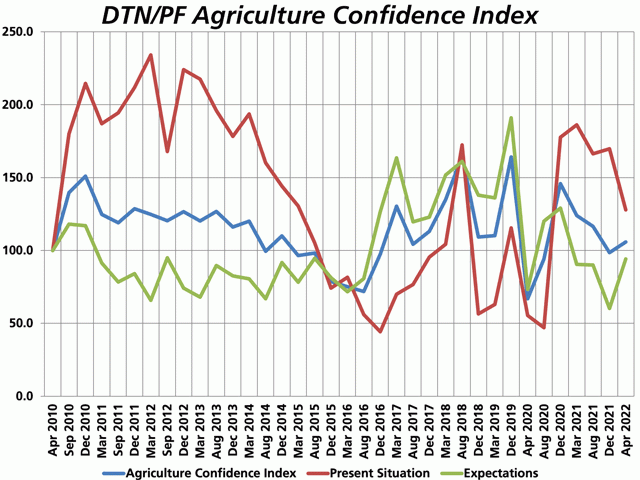Agriculture Confidence Index Results
DTN/The Progressive Farmer Agriculture Confidence Index Finds Input Costs Temper Farmer Optimism
COLUMBIA, Mo. (DTN) -- Farmers have a mixed bag of feelings as we head into a delayed 2022 planting season.
The latest DTN/The Progressive Farmer Agriculture Confidence Index is a slightly optimistic 105.8, up slightly from the 98.5 in December and down 17 points from spring 2021. The latest survey of 500 farmers was conducted in late March and April.
Index numbers above the baseline score of 100 indicate optimism -- the higher the number, the higher that optimism. Scores below 100 are considered pessimistic.
Commodity prices continue their bullish ways, with corn bids hitting $8 per bushel during the survey period. But high prices are tempered by two key issues. First, most farmers have sold the bulk of their 2021 harvest, so there isn't a lot of grain to move to fetch high prices. Second, there is no letup in the climb of crop input prices either, as fertilizers reach two to three times their historical average levels and retail diesel fuel continues to hang around $5 per gallon, twice its 2021 price.
This spring's survey also showed significant differences in regional attitudes, as the third year in a row of La Nina weather pattern keeps major areas of the West and Southwest in extreme to exceptional drought levels, according to the U.S. Drought Monitor and DTN's own soil moisture tracking.
The Agriculture Confidence Index survey is conducted via telephone interview with farmers three times each year. Farmers are asked questions about how they feel current economic and financial conditions are compared to a year ago, and how they estimate conditions will be a year from current. Those questions create "present condition" and "future expectations" scores, respectively, that are then combined to create the overall Index.
Present situation scores, while still optimistic, were down considerably to 127.9 versus 169.8 at the end of 2021 and the even more optimistic score of 186.2 a year ago.
P[L1] D[0x0] M[300x250] OOP[F] ADUNIT[] T[]
Overall future expectations were up from the end of 2021, at 94.2 versus 60.1 in December 2021 and relatively flat with 90.5 a year ago.
More than a third of farmers said they expect net farm incomes to be worse in the coming 12 months than current, while 21% expected better income and 45% expected incomes to be similar by 2023.
More than 60% said prices paid for crop and livestock inputs were worse than normal, with 21% reporting normal prices.
In addition to standard Agriculture Confidence questions, farmers were also asked a series of questions about the upcoming season and plans for it.
With inflation climbing and interest rates inching upward, farmers also showed an increased concern about operating loans. While 59% said they were not concerned about access to loans, 27% were somewhat concerned and 12% were very concerned, a slight uptick from previous Agriculture Confidence Index survey periods.
When asked about major concerns for the upcoming season, high input costs were the No. 1 item on farmers' list, with 51% of respondents saying it was their chief concern. The survey found 27% listed drought conditions, and 14% listed the war in Ukraine as their main concern for the coming crop season.
SOUTHWEST SUFFERS
Regionally, the southwest has significantly lower scores, no doubt based on the prolonged drought in the region. The overall index for the region is a pessimistic 77.4, with a present score of 84.3 and future expectations coming in at an even lower 74.6.
That compares to an Index of 105.2 in the Southeast and 117 with Midwest farmers. Midwest farmers even gave their present situation a score of 131.3, likely driven by continued bullish corn and soybean prices, with some cash grain prices hitting $8 per bushel for corn and more than $16 per bushel for soybeans according to DTN's cash grain market tracker. Even if few farmers had 2021 harvest bushels to sell at those prices, the prospect apparently buoyed their outlook despite the growing war in Ukraine, increasing inflation, and the skyrocketing costs of crop inputs, equipment parts and other farm expenses.
Major portions of New Mexico, Texas, and western Oklahoma and Kansas continue to be under extreme to exceptional drought categories, according to the U.S. Drought Monitor, which is available on DTN subscription digital platforms.
AGRIBUSINESS PESSIMISM GROWS
While conducting the farmer survey, DTN talks to at least 100 farm suppliers, elevators, equipment dealers and other agri-businesses to get their opinions on the ag economy.
The DTN/The Progressive Farmer Agribusiness Confidence Index for spring is 94.5, essentially flat from the 97.8 of December 2021 and a continued fall from the 122.9 of spring 2021. All scores show a drop from the high of a year ago, with the spring 2022 present condition score of 109.5, compared to 124.5 a year earlier, and a future expectations score of a pessimistic 83.6, flat with December 2021 but down from 121.5 a year ago.
The next DTN/The Progressive Farmer Agriculture Confidence Index survey will take place in August 2022.
Greg D. Horstmeier can be reached at greg.horstmeier@dtn.com
Follow him on Twitter @greghorstmeier
(c) Copyright 2022 DTN, LLC. All rights reserved.




